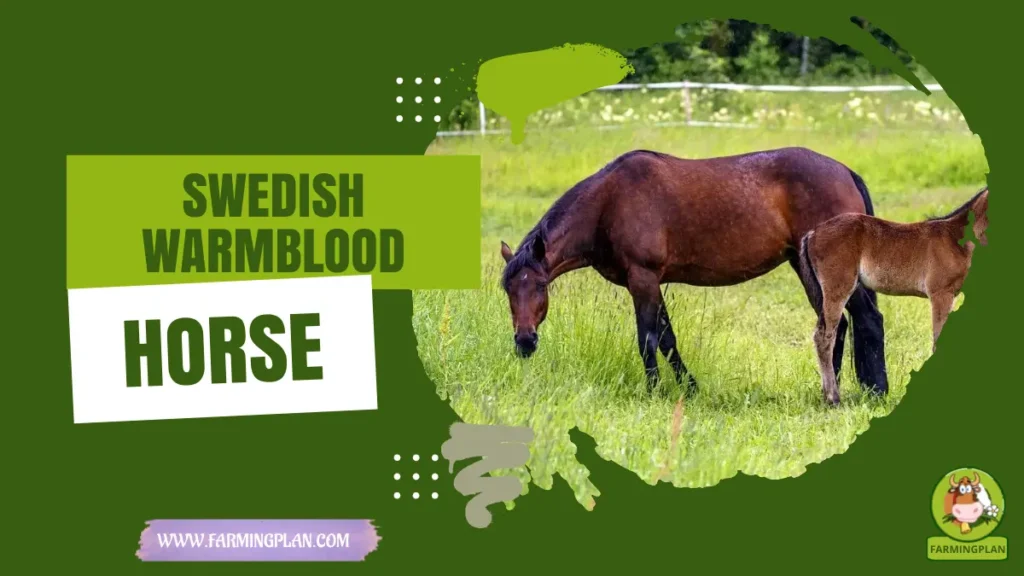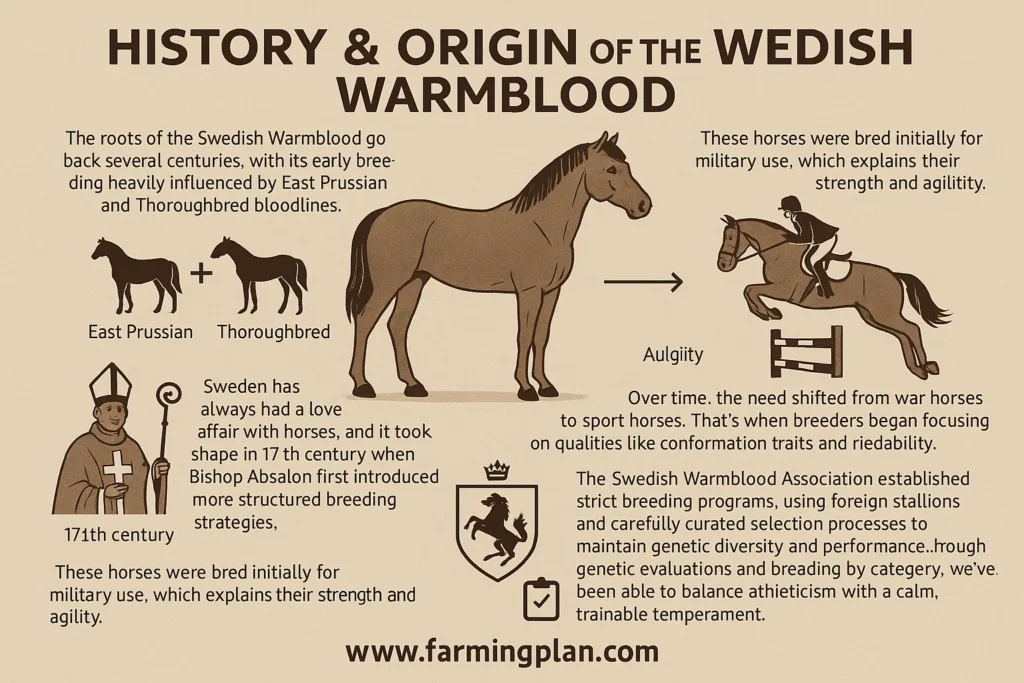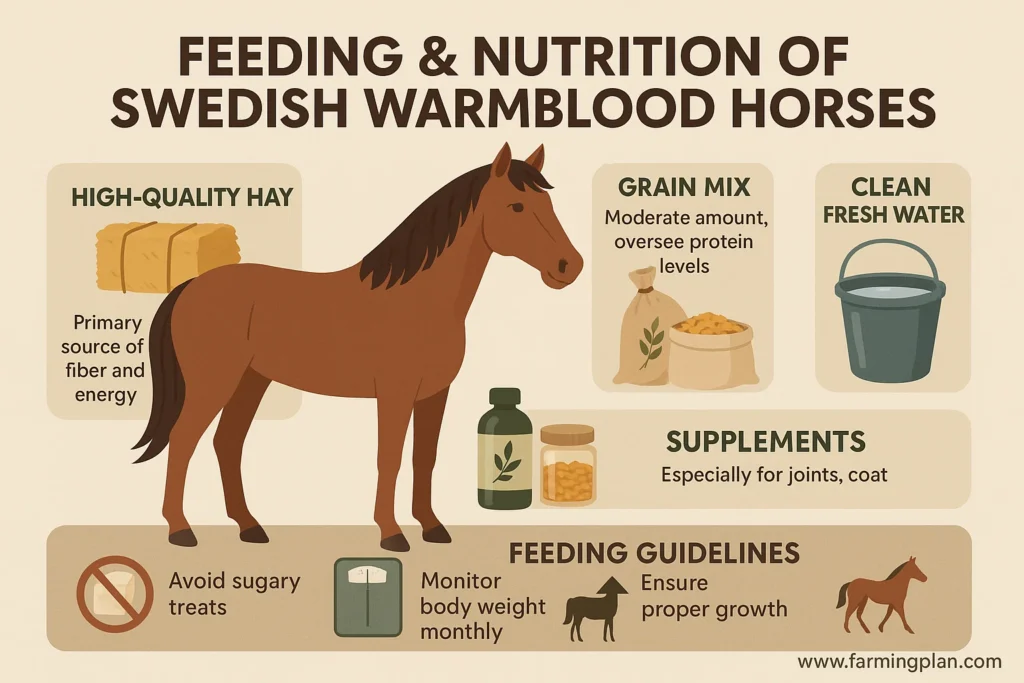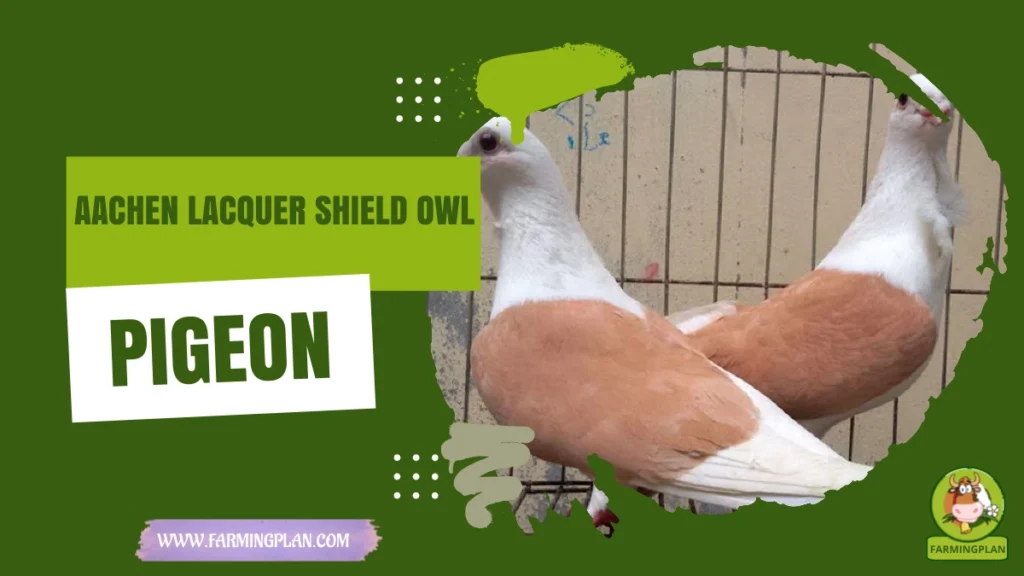If you’re anything like me and have a soft spot for elegant, intelligent, and incredibly versatile horses, then the Swedish Warmblood Horse might just steal your heart. I’ve worked with many breeds, but these horses are special in my barn and my experience. The Swedish Warmblood Horse is widely respected in dressage and eventing, yet it’s also gentle and steady enough for everyday riders. In this article, I’ll walk you through everything you need about these amazing horses—from their origin story and temperament to feeding, care, and health tips. So, whether you’re a breeder, a hobbyist, or a horse-loving farmer like me, saddle up, and let’s dive into the wonderful world of Swedish Warmblood Horse.

History & Origin of the Swedish Warmblood
The roots of the Swedish Warmblood Horsego back several centuries, with its early breeding heavily influenced by East Prussian and Thoroughbred bloodlines. Sweden has always had a love affair with horses, and it took shape in the 17th century when Bishop Absalon first introduced more structured breeding strategies. These horses were bred initially for military use, which explains their strength and agility.

Over time, the need shifted from war horses to sport horses. That’s when breeders began focusing on qualities like conformation traits and rideability. The Swedish Warmblood Horse Association established strict breeding programs, using foreign stallions and carefully curated selection processes to maintain genetic diversity and performance. Through genetic evaluations and breeding by category, we’ve been able to balance athleticism with a calm, trainable temperament.
Physical Characteristics of Swedish Warmblood Horse
Let me paint you a picture. Swedish Warmblood Horse usually stand tall—anywhere from 165 to 170 cm. They carry themselves with natural elegance, long legs, well-sloped shoulders, and a strong back. Their movement is fluid, almost like dancing, making them ideal for dressage. But don’t be fooled by the grace—these horses are strong and built to handle show jumping and cross-country just as well.
Colors vary, but you’ll mostly find them in bay, chestnut, gray, and black. Their body growth and size are closely monitored in breeding programs using tools like linear profiling. I always look for signs of good confirmation, which means fewer health issues and better long-term performance. Whenever I assess a horse, I check its movement, balance, and overall symmetry.
Read more: Discover The Irish Sport Horse: Your Dream Athletic Companion
Temperament & Behavior of Swedish Warmblood Horse
I love working with Swedish Warmblood Horse—they’re thoughtful, steady, and willing. I’ve trained both pros and amateurs with this breed, and I’ve found them incredibly responsive. Their temperament makes them perfect for riders at any level. They’re not too hot-headed like some Thoroughbreds, but they’re not sluggish either. It’s that sweet spot of energy and calm.

What’s more, they genuinely want to please their rider. This trait is primarily thanks to decades of positive selection in the breeding process. You get a horse that not only performs but also connects with you. When training a new rider or competing, I can count on a Swedish Warmblood to read the room and do the job right.
Feeding & Nutrition of Swedish Warmblood Horse
Feeding a Swedish Warmblood Horse Horse isn’t complicated, but it takes some strategy. I usually start with a balanced base of high-quality hay—their primary source of fiber and energy. Then, I layer in a moderate grain mix but oversee the protein levels. Too much protein can lead to joint stress or mood swings.

I also include supplements, especially for joint health and coat shine. Ensure clean, fresh water is always available, and avoid sugary treats—they don’t do their gut any favors. Monitor body size and weight monthly to ensure they’re not underfed or overfed. These horses grow fast, so it’s crucial to feed in a way that supports their development without encouraging unhealthy weight gain.
Main Uses: More Than Just a Show Horse
Swedish Warmblood Horse are the go-to choice for dressage, but that’s just the beginning. They also excel in show jumping, eventing, and casual trail riding. I’ve seen horses from this breed compete under world-class riders like Sara Algotsson-Ostholt and Malin Baryard, winning medals and hearts alike.
But here’s the cool part—they’re also great for everyday riders. Whether you’re a hobbyist looking for a reliable partner or a farmer needing a versatile workhorse, Swedish Warmblood Horse can do it all. The Swedish warmblood horse price reflects that versatility, usually ranging from $10,000 for young ones to $60,000+ for well-trained champions.
Read more: Swedish Warmblood Horse: The Surprising Advantages You Didn’t Know About
Unique Features of Swedish Warmbloods
So, what makes Swedish Warmblood Horse truly stand out? For starters, they have a strong genetic base. Breeders can predict performance traits and avoid hereditary issues thanks to detailed breeding plans and whole-genome sequencing data. These horses show incredible gait scores and high conformation trait reliability.
Another standout is their adaptability. I’ve worked with some that are perfect for amateur riders and others that thrive under elite-level pressure. Their athletic performance doesn’t come at the cost of mental soundness. That’s a rare combo in the horse world. And unlike mutt horses, every Swedish Warmblood has a detailed pedigree that helps you understand exactly what you’re getting.
Common Health Concerns & How to Prevent Them
Even with the best breeding, Swedish Warmbloods can face health challenges. The most common issues I’ve encountered are joint problems, especially in older or overworked horses. Lameness and digestive issues can also occur if feeding isn’t carefully managed.
Prevention is key. Regular vet checkups, proper hoof care, and balanced nutrition go a long way. Genetic evaluations also help spot potential problems early. Studies in journals like Anim Genet and Livest Sci provide great insight into health trends and prevention strategies. I always tell new owners that the best way to avoid health problems is to think ahead and stick to a consistent care routine.
Great Care Begins With Daily Habits, Gentle Hands, And A Horse That Knows It’s Loved.
Step-by-Step Care Guide for Swedish Warmblood Owners
Want your Swedish Warmblood to thrive? This easy step-by-step care guide covers shelter, feeding, grooming, exercise, and vet routines from a horse care expert. Here’s a rewritten, more detailed version of the 5-step care guide, keeping the friendly and practical tone consistent throughout.
Step 1: Set Up a Safe and Spacious Shelter
Swedish Warmbloods are big horses with even bigger hearts—they need a space that supports both. Start with a well-ventilated barn that’s clean, dry, and roomy enough for them to lie down and move around comfortably. I recommend rubber flooring to cushion joints and reduce slipping, especially in wet weather. Don’t forget access to a large, grassy paddock or pasture. These horses love to roam, graze, and stretch out.
Do a daily walk-through of the shelter. Look for loose boards, rusty nails, or anything sharp that could cause injury. I once found a splintered gate hinge just in time—it could’ve been a disaster. Creating a safe, calm space lays the groundwork for a confident and relaxed horse.
Step 2: Create a Daily Feeding and Watering Schedule
Feeding your Swedish Warmblood isn’t just about filling a trough—it’s about balance. I feed hay two to three times daily, ensuring it’s clean and dust-free. Depending on the horse’s age, workload, and health, I’ll add a grain mix or pelleted feed for extra energy. Growing foals or competition horses may need more, while mature or lightly worked horses often need less.
Water is non-negotiable. Fresh, clean water should be available 24/7. Depending on the season, I constantly mix a salt lick in the stall in joint support or coat supplements. Monitor their body condition monthly using visual cues or a weight tape. Subtle weight or coat shine changes can hint at deeper issues, so stay alert.
Step 3: Plan a Balanced Exercise Routine
Swedish Warmbloods are born athletes—but even the best need innovative training. I stick to a mix of physical and mental challenges. On average, I do 45-minute sessions 4–6 days a week. I rotate between dressage, flatwork, and trail rides. Trail rides give them a mental break, while dressage builds strength and focus. If you’ve got access to poles or jumps, add variety to prevent boredom.
Warm up for at least 10 minutes, and always cool down after. Don’t push too hard, especially with younger horses. Progress comes from consistency, not intensity. And always—and I mean always—end on a good note. A happy horse will be eager to work with you again tomorrow.
Step 4: Keep Up With Grooming and Hoof Care
Grooming is more than just about looking good—it’s your daily check-in. Every morning, I brush from ears to tail, checking for cuts, swelling, or skin conditions. Their coats love a curry comb and stiff brush combo, and I throw in a conditioning spray weekly for that extra shine. It’s also a great bonding experience, especially with young or new horses.
Daily hoof cleaning is essential. Check for lodged stones, cracks, or signs of thrush. Book your farrier every 6–8 weeks, like clockwork. One time, I delayed a trim during a busy season—never again. Trust me, solid hoof care equals longevity and soundness when it comes to Swedish Warmbloods.
Step 5: Schedule Routine Vet Visits and Vaccinations
Even the healthiest-looking Warmblood needs regular checkups. I schedule vet visits every six months—spring and fall are good benchmarks. During these visits, we handle vaccinations, dental checks, and an overall wellness review. Dental care is often overlooked but critical; uneven teeth can lead to poor digestion or bit issues.
I keep a dedicated vet log in a binder—dates, symptoms, meds, and anything unusual. It’s come in handy more than once. Preventive care saves you from expensive surprises and helps your horse live a longer, healthier life. And let’s be honest: peace of mind is worth every penny.Expert Tips & Best Practices
Read more: Oldenburg Horses: The Strength and Elegance You Never Expected in a Single Breed
Expert Tips & Best Practices
- Choose your stallions based on verified breeding values.
- Use genetic reports to guide your selection and avoid overbreeding.
- Watch trends in the Journal of Animal Breeding and Genetics to stay informed.
- Prioritize gait training early—it pays off in competitions.
- Keep a care journal to track daily behavior, feed, and medical notes.
FAQ
What is a Swedish Warmblood Horse used for?
They’re mainly used for dressage, show jumping, and eventing, but they also make great companions for casual riding.
How much does a Swedish Warmblood Horse cost?
Prices range from $10,000 to over $60,000, depending on age, bloodline, and training.
What is the temperament of Swedish Warmbloods?
They’re calm, intelligent, and eager to please, making them great for both beginners and pros.
Are Swedish Warmbloods suitable for beginners?
Absolutely! Their steady temperament and trainability make them a favorite among new riders.
How tall do Swedish Warmblood Horses grow?
They typically stand between 165 and 170 cm (16.1 to 17 hands tall).
Conclusion
The Swedish Warmblood Horse isn’t just a pretty face. It’s an intelligent, capable, loyal breed that suits first-time riders to elite competitors. With a rich history, great temperament, and reliable athletic performance, this breed offers the complete package. I’ve spent years working with these horses, and they’ve never let me down. Whether you’re breeding, riding, or just admiring from afar, Swedish Warmbloods are truly a breed worth knowing and loving.


